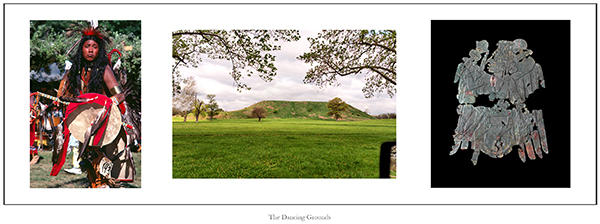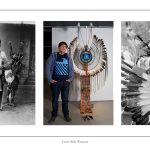On The Road with Birdman

Click on anchor points to view corresponding panel and title. You can move the map around by clicking and dragging. View a larger version of the map by clicking on the [ ] brackets on the top right of the map.

1. The Dancing Grounds (2016) pigment print on archival paper, 24” x 36”
TRAVELOGUE: Collinsville, Illinois, April 18, 2015, Cahokia complex
I am sitting in the parking lot of Monks Mound, the largest indigenous earth mound north of Mexico, and imagining what it must have looked like in the 11th century. Some archaeologists estimate that Cahokia was home to as many as 20,000 people. Since Monks Mound was the central ceremonial area, I wonder if the Birdmen carried out their rituals here.
Nearby is Mound 34, where excavations revealed the remains of a copper workshop. The copper Birdman plates from the area remind me of a photograph I made of powwow dancer Jack Moore in 1982, shown here.
KEY TO IMAGES (left to right)
Jeff Thomas, Jack Moore, Pima Nation (1982) Grand River Powwow, Six Nations Reserve, GPS: 43.114367 -80.11235
Jeff Thomas, Mississippian Homeland, Monk’s Mound (2015) Collinsville, Illinois, GPS: 38.660083 -90.05875
Donald E. Hurlbert, Rogan Plate Birdman, Catalog number A91117, Department of Anthropology, Smithsonian Institution
The following description is from the Smithsonian website:
“Birdman or falcon dancer,” a figure now identified as representing the Upper World in the Southeastern Ceremonial Complex. Each of the figures is in an energetic stance, possibly dancing. They have upraised right arms holding ceremonial stone maces and lowered left arms holding severed heads. On the figures; heads are elaborate headdresses with bi-lobed arrow motifs (identical to copper plate pieces also found at the site) and beaded forelocks. On the front of the headdress, in the forehead area, is a rectangular object, thought by scholars to represent a sacred medicine bundle. Each figure has a long sash hanging from a belt and a motif known as the “bellows apron” attached at the waist. This is thought to represent a “scalp,” as the ornament has the same sort of bundle as the figures wear in their hair (although of a slightly different design), attached to a shape interpreted as hair. The faces of the severed heads have the forked eye motif, in contrast to the faces of the figures.

2. Returning The Gaze: Two Assiniboine Men (2009/2015) pigment print on archival
paper
KEY TO IMAGES (left to right):
Jeff Thomas, Kevin Haywahe (Powerful Walking Wolf) (1991) Weston Memorial Community Centre Rink, Winnipeg, Manitoba, GPS: 49.92092 -97.1925
Edward S. Curtis, Chief Black Eagle (Wa-budiI- sapa) (1908) Assiniboine, courtesy Library of Congress/LC-USZ62- 105371
Jeff Thomas, Kevin Haywahe (Powerful Walking Wolf) (1991) Weston Memorial Community Centre Rink, Winnipeg, Manitoba, GPS: 49.92092 -97.1925

3. Get Up And Dance (2010) pigment print on archival paper
KEY TO IMAGES (left to right):|
John A. Brown, Ske-O- Ke-Mow (Earth Chief) (1921) Wetaskawin, Saskatchewan, courtesy John A. Brown/ Library and Archives Canada/PA-030780
Jeff Thomas, Jack Moore, Pima Nation (1983) Grand River Powwow, Six Nations of the Grand River, GPS: 43.06862 -80.06741

4. “One Of The Past?” (2009/2017) pigment print on archival paper
KEY TO IMAGES (left to right):
G.E. Fleming, One of the Past, A Cree Man (1904) Saskatchewan, courtesy of: G.E. Fleming / Library and Archives Canada / C-006973
Jeff Thomas, Terrance Rain (Cree) (1991) Winnipeg, Manitoba, GPS: 49.53299 -97.08689
Jeff Thomas, Terrance Rain (Cree) (1991) Winnipeg, Manitoba, GPS: 49.53299 -97.08689

5. Birdmen (2015) pigment print on archival paper
TRAVELOGUE: April 22, 2015, The Ethnology Museum Laboratory
(EML), department of anthropology, Southern Illinois University Edwardsville
My photograph of the Birdman gorget inspired this panel. My intent is to illustrate continuity from the ancient indigenous past of the Mississippians, to the 19th century resistance warrior, and finally, to the 21st century with my portrait of a traditional powwow dancer.
The Young Kiowa Man image shows a 19th century warrior at Fort Sill, which was a military headquarters and an agency for several tribes, including the Kiowa, Wichita, and Comanche. When I photographed Michael White Eyes, I was working for the Aboriginal Justice Inquiry in Winnipeg, Manitoba. My role gave me access to the powwow dance floor and within feet of the dancers. I was so close in fact that I felt like I could hear the dancers’ bustles. I was surrounded by Birdmen.
KEY TO IMAGES (left to right):
William S. Soule, 1836-1908, Young Kiowa Man in War Dress (taken between 1867 and 1874) Fort Sill, Indian Territory (now the state of Oklahoma). Fort Sill was a military headquarters and an agency for several tribes, including the Kiowa, Wichita, and Comanche. National Anthropological Archives, Smithsonian Museum, NAA INV 01625301
Jeff Thomas, Shell gorget (pendent) with incised Birdman symbol (2015) Courtesy of The University Museum at Southern Illinois, Edwardsville, GPS: 38.783467 -89.987367
Jeff Thomas, Michael White Eyes (Lakota) (1991) Winnipeg, Manitoba, GPS: 49.888317 -97.144817

6. Birds-Eye-View (2009) pigment print on archival paper, 30” x 59”
TRAVELOGUE: June 6, 2006, Coaldale, Alberta, Alberta Birds of Prey Foundation
While in Lethbridge, Alberta, we made a side trip to nearby Coaldale, to take part in the flying demonstration with the birds of prey. The image shows a Red-Tailed Hawk landing on my arm. Now I have an image for my new work with Medicine Crow, who was photographed by Edward S. Curtis. My objective is to present the revered relationship men like Medline Crow had with the bird of prey.
Edward Curtis: The passing of every old man or woman means the passing of some tradition, some knowledge of sacred rites possessed by no other; consequently the information that is to be gathered, for the benefit of future generations, respecting the mode of life of one of the great races of mankind, must be collected at once or the opportunity will be lost for all time. It is this need that has inspired the present task.
KEY TO IMAGES (left to right)
Edward S. Curtis, Medicine Crow, Apsaroke, (Crow) (c. 1908) Crow Reservation, Montana, c, approximate longitude and latitude N45 36.090 W107 27.643, courtesy of the Library of Congress/LC- USZ62-106886
Brenda Lafleur, Red Tail Hawk (2006) Alberta Birds of Prey Foundation, Coaldale, Alberta, GPS: 49.731017 -112.629883 (the hawk is landing on my arm)
Edward S. Curtis, Medicine Crow (frontal), Apsaroke (Crow) (c.1908) Crow reservation, Montana, GPS: 45.6015 -107.460717, courtesy of the Library of Congress/LC-USZ62- 98537, this image was not published in TNAI

7. Mississippian Mound Builders (2016) pigment print on archival paper
TRAVELOGUE: April 23, 2015
Hidden in a clump of brush on Collinsville Avenue is an ancient Mississippian era earth mound, built sometime between the 10th and 12th centuries. The mound is part of a massive urban complex known today as Cahokia. I photographed the site from my tour guide’s SUV. My trip to the St. Louis area was to learn more about the Mississippians, their artists, and the revered Birdman figure; a mythological figure that was a synergism of warrior and bird of prey.
Although the Birdman figure in this panel was probably not discovered in this particular mound, this was the Birdman’s homeland. While looking around the depressed urban landscape of East St. Louis, my thoughts returned to Oshawa and the hawk that visited me – did the hawk lead me here?
KEY TO IMAGES (left to right):
Left & Right: Jeff Thomas, Mississippian Birdman Figure in profile and frontal poses (2015) Courtesy of The University Museum, Southern Illinois University Edwardsville, GPS: 38.783467 -89.987367
Centre: Jeff Thomas, An ancient Mississippian earth mound covered by brush (2015) East St. Louis, Missouri, coordinates withheld

8. Crow Belts Wearers (2016) pigment print on archival paper
Key to images (left to right)
Charles H. Carpenter, Fred Murie, wearing Pawnee costume, Skidi Pawnee (Oklahoma 1904) Courtesy/ National Anthropological Archives, Smithsonian Institution
Jeff Thomas, Barry Ace, Urban Bustle (2016)
Jeff Thomas, Gerald Cleveland with Dance Bustle (1985)

9. Return The Gaze (2012/2017) pigment print on archival paper
KEY TO IMAGES: (left to right)
Jeff Thomas, Ira Makes Him First, Lakota (1991) Winnipeg, Manitoba, GPS: 49.888317 -97.144817
Gertrude Kasebier, Joe Black Fox (Lakota) (1900) New York City
View the other Portfolios from this series:
ON THE ROAD WITH BIRDMAN
STRONG HEARTS: MY JOURNEY WITH BIRDMAN
REBINDING THE NORTH AMERICAN INDIAN













